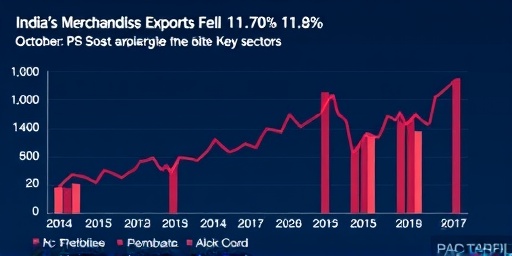In a stark indicator of escalating global trade frictions, India’s merchandise exports plummeted by 11.8% year-on-year in October, reaching just $33.5 billion compared to $38 billion in the same month last year. This sharp decline comes on the heels of a controversial US tariff hike on imported goods, which has directly targeted vital Indian industries and amplified concerns over the nation’s economic trajectory.
The data, released by the Ministry of Commerce and Industry, underscores the vulnerability of India exports to international policy shifts, particularly from the United States, India’s largest trading partner. With petroleum products, gems, and jewelry among the hardest-hit categories, the fallout is rippling through supply chains and employment in export-dependent regions.
US Tariff Escalation Triggers Export Slump
The recent surge in US tariffs, imposed under the guise of protecting domestic industries, has created significant barriers for Indian exporters. In September, the US administration announced a 25% increase on tariffs for select categories of electronics, textiles, and even some agricultural inputs, but the ripple effects have been most pronounced on non-oil merchandise. Economists attribute the 11.8% drop directly to these measures, noting that US-bound shipments from India fell by over 15% in the month.
According to trade analyst Rajesh Kumar from the Federation of Indian Export Organisations (FIEO), ‘The US tariffs are not just a tax; they’re a chokehold on bilateral trade flows. India exports have been resilient in the past, but this targeted hike is forcing companies to rethink strategies overnight.’ This sentiment echoes across the board, as preliminary figures show core exports—excluding petroleum and gems—contracting by 9.2%, a worrying trend for India’s diversified trade portfolio.
Historical context reveals that US-India trade relations have been strained since the 2018 trade war era, but recent escalations under new policies have intensified the pressure. In fiscal year 2023-24, India exported $78 billion worth of goods to the US, making up nearly 18% of total India exports. The October figures represent the steepest monthly decline since the COVID-19 disruptions in 2020, highlighting how swiftly US tariffs can alter economic landscapes.
Petroleum Sector Bears Brunt of Tariff Pressures
Petroleum products, a cornerstone of India exports, saw exports value shrink by 20.3% to $10.2 billion in October, largely due to volatile global oil prices compounded by US tariffs on refined fuels. India, as the world’s third-largest oil consumer, relies heavily on exporting refined petroleum to the US, where demand remains robust but now comes at a higher cost.
The economic impact is multifaceted: refineries in Gujarat and Maharashtra, which account for 60% of India’s petroleum exports, are facing margin squeezes as tariffs add up to 10% extra duties on certain crude derivatives. ‘We’ve seen a 12% drop in orders from US buyers this quarter alone,’ said Amit Sharma, director at Reliance Industries’ export division. This sector alone contributed to over half of the overall export decline, underscoring its outsized role in the trade balance.
Beyond immediate losses, the petroleum downturn threatens ancillary industries like shipping and logistics, where thousands of jobs are at stake. Government data indicates that petroleum exports supported 1.2 million direct jobs in FY23, and any sustained dip could exacerbate unemployment in coastal economic hubs. Moreover, with Brent crude prices hovering around $85 per barrel, Indian exporters are caught between high input costs and tariff-induced barriers, forcing some to pivot to alternative markets like Europe and Southeast Asia.
Gems and Jewelry Exports Hit by Luxury Tariff Walls
The gems and jewelry sector, renowned for its craftsmanship in Surat and Jaipur, experienced a 14.5% year-on-year decline, with exports totaling $1.8 billion in October. US tariffs on luxury goods, raised to 15% for items over $800 in value, have deterred high-end buyers and disrupted supply chains for polished diamonds and gold jewelry—key staples of India exports to the American market.
This sector’s woes are particularly acute given its labor-intensive nature; it employs over 5 million artisans, predominantly in informal setups. ‘The tariff hike is killing small-scale exporters who can’t absorb the costs,’ lamented industry veteran Priya Mehta of the Gem and Jewellery Export Promotion Council (GJEPC). US imports from India in this category dropped 18% month-on-month, as retailers like Tiffany & Co. and local jewelers seek cheaper alternatives from non-tariffed sources.
Adding to the challenge, global demand for lab-grown diamonds has surged, but US policies favor domestic production, sidelining Indian innovations. The economic impact extends to raw material imports; India imports 90% of its rough diamonds from Africa, and tariff retaliations could inflate costs further. In response, the Indian government has initiated talks for tariff exemptions under the proposed US-India free trade agreement, but progress remains slow amid election-year politics in Washington.
Broader Trade Disruptions and Domestic Economic Ripples
Beyond petroleum and gems, the US tariffs are reshaping India’s overall trade dynamics, with non-oil exports falling 8.7% to $23.3 billion. Sectors like pharmaceuticals and automobiles, while somewhat insulated, are bracing for spillover effects as global supply chains realign. The rupee’s depreciation to 83.5 against the dollar offered some cushion, but it wasn’t enough to offset the tariff-induced losses.
India’s trade deficit widened to $25.1 billion in October, up from $19.8 billion the previous year, as imports grew modestly by 2.4%. This imbalance amplifies the economic impact, pressuring foreign exchange reserves and potentially stoking inflation in import-dependent areas like electronics. Commerce Minister Piyush Goyal addressed Parliament, stating, ‘We are diversifying markets aggressively—exports to ASEAN grew 12%—but US tariffs demand a multilateral response through WTO channels.’
On the domestic front, states like Tamil Nadu and Maharashtra, which host major export processing zones, are reporting factory slowdowns. A survey by the Confederation of Indian Industry (CII) found that 65% of exporters anticipate further declines in Q4 unless tariffs are rolled back. This could shave 0.5% off India’s GDP growth projection for FY25, currently estimated at 7%, according to RBI forecasts.
Stakeholder reactions vary: while large conglomerates like Tata and Adani explore US manufacturing setups to bypass tariffs, SMEs—comprising 45% of exporters—face existential threats. Initiatives like the Production Linked Incentive (PLI) scheme aim to boost domestic value addition, but experts warn that without swift trade negotiations, the economic impact on employment and investment could deepen.
Outlook: Navigating Trade Turbulence and Policy Responses
Looking ahead, Indian policymakers are gearing up for a challenging trade environment, with US tariffs likely to persist through the upcoming administration transition. The government plans to launch a $2 billion export credit guarantee fund in November to support affected sectors, while pushing for bilateral dialogues at the G20 summit.
Market watchers predict a modest recovery in December if holiday season demand offsets tariffs, but sustained US-India trade tensions could redirect India exports toward the EU and Middle East, where growth in green energy and textiles offers opportunities. ‘Resilience will be key; diversification isn’t optional anymore,’ notes economist Arjun Sengupta from the Indian Institute of Foreign Trade.
For businesses, the path forward involves digital upgrades and compliance with US sustainability standards to regain competitive edges. As India aims to hit $1 trillion in exports by 2030, overcoming these hurdles will test the nation’s strategic agility in a tariff-laden world. Stakeholders urge a unified front, blending diplomacy with innovation, to mitigate the long-term economic impact and secure stable trade pathways.









